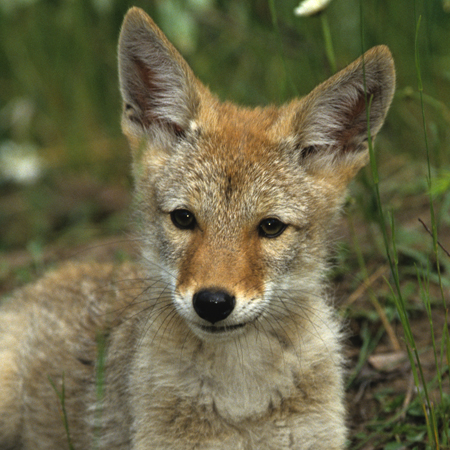It’s Spring, and babies are hiding everywhere. Does tuck their
fawns in the tall grass, and quail are nesting in the bottlebrush. Grey foxes
have their kits in an old barn down the road. A few years ago, this male kit was so bold
he snoozed on our deck.
And out there in the brush are coyote pups. As cute as they may seem, it's best for you and for them to keep your distance.
Unlike dogs, coyotes breed once a year. Pups are born in
March or April. Weighing approximately 250 grams at birth, they are blind
and limp-eared. The eyes open and ears become
erect after 10 days. Around 21–28 days after birth, the young begin to
emerge from the den, and by 35 days, they are fully weaned. Litter size ranges
from one to 15 pups; the average is six. About 50–70% of pups do not
survive to adulthood.
Female coyotes prefer a dry, safe place to have their pups.
A typical den site is a brush and tree pile. Or under the base of a large,
standing tree that has an opening at ground level. Coyote pups sometimes are
raised in hollow logs and under rock ledges. Most pups are moved several times
by the time they are old enough to leave the den on their own. If the pups are
too small to follow their mother, she carries them one at a time by the nape of
the neck to the new den site.
Coyotes are rarely dangerous to humans, except when the pups
are threatened. If you see what look like cute, romping puppies in the wild,
do not approach them. They may be coyote
pups, and the parents may be nearby. Call your local animal rescue service if you
fear the pups have been abandoned. Do not try to rescue them yourself.
If the coyotes are coming closer to your home
than you’d like, here are some suggestions:
·
Do not leave out food or water. Secure your
garbage. Move any bird feeder inside a coyote proof fence. Keep small pets
inside, particularly at dawn and dusk when coyotes are most active.
Try "hazing” techniques. Use noise makers,
whistles, and other deterrents. Yell. Act big and scary. The bigger the better. Here are some helpful links:Humane Society Hazing Techniques
Project Coyote Hazing Brochure
Don’t haze… if
it is March through July, and you are in a park or open space and think you could be near a coyote den, or if you think that pups could be present. Allow them breathing room to raise and protect their new families. Be aware that you may encounter a coyote who is trying to haze you
away from his den by acting anxious and/or assertive. He may attempt to escort you to a safe distance by hunching his back and walking towards you, or by vocalizing (barking or “huffing”). Please leash dogs and pick up small pets and leave the area calmly. Do not run.
Don’t haze… if
the coyote is at a comfortable distance from you. Seeing a coyote at a distance is no cause for alarm. They have adapted to
urban environments and may be seen during the day or night.




No comments:
Post a Comment